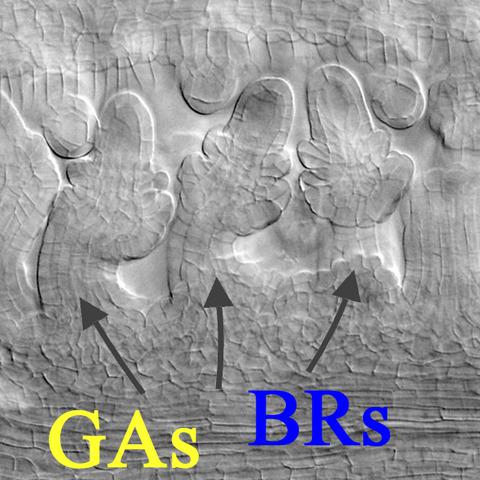Our official English website, www.x-mol.net, welcomes your
feedback! (Note: you will need to create a separate account there.)
Regulation of ovule initiation by gibberellins and brassinosteroids in tomato and Arabidopsis: two plant species, two molecular mechanisms.
The Plant Journal ( IF 6.2 ) Pub Date : 2020-01-13 , DOI: 10.1111/tpj.14684 Daniela Barro-Trastoy 1 , Esther Carrera 1 , Jorge Baños 1 , Julia Palau-Rodríguez 1 , Omar Ruiz-Rivero 1 , Pablo Tornero 1 , José M Alonso 2 , Isabel López-Díaz 1 , María Dolores Gómez 1 , Miguel A Pérez-Amador 1
The Plant Journal ( IF 6.2 ) Pub Date : 2020-01-13 , DOI: 10.1111/tpj.14684 Daniela Barro-Trastoy 1 , Esther Carrera 1 , Jorge Baños 1 , Julia Palau-Rodríguez 1 , Omar Ruiz-Rivero 1 , Pablo Tornero 1 , José M Alonso 2 , Isabel López-Díaz 1 , María Dolores Gómez 1 , Miguel A Pérez-Amador 1
Affiliation

|
Ovule primordia formation is a complex developmental process with a strong impact on the production of seeds. In Arabidopsis this process is controlled by a gene network, including components of the signalling pathways of auxin, brassinosteroids (BRs) and cytokinins. Recently, we have shown that gibberellins (GAs) also play an important role in ovule primordia initiation, inhibiting ovule formation in both Arabidopsis and tomato. Here we reveal that BRs also participate in the control of ovule initiation in tomato, by promoting an increase on ovule primordia formation. Moreover, molecular and genetic analyses of the co-regulation by GAs and BRs of the control of ovule initiation indicate that two different mechanisms occur in tomato and Arabidopsis. In tomato, GAs act downstream of BRs. BRs regulate ovule number through the downregulation of GA biosynthesis, which provokes stabilization of DELLA proteins that will finally promote ovule primordia initiation. In contrast, in Arabidopsis both GAs and BRs regulate ovule number independently of the activity levels of the other hormone. Taken together, our data strongly suggest that different molecular mechanisms could operate in different plant species to regulate identical developmental processes even, as for ovule primordia initiation, if the same set of hormones trigger similar responses, adding a new level of complexity.
中文翻译:

赤霉素和油菜素类固醇在番茄和拟南芥中对胚珠萌发的调控:两种植物,两种分子机制。
胚珠原基的形成是一个复杂的发育过程,对种子的生产有很大影响。在拟南芥中,该过程由基因网络控制,包括生长素,油菜素类固醇(BRs)和细胞分裂素的信号传导途径的组成部分。最近,我们已经表明,赤霉素(GAs)在胚珠原基的启动中也起着重要作用,抑制拟南芥和番茄中胚珠的形成。在这里,我们揭示了BRs通过促进胚珠原基形成的增加也参与了番茄胚珠起始的控制。此外,GA和BR共同调控胚珠萌发的分子和遗传分析表明,番茄和拟南芥中存在两种不同的机制。在番茄中,GA在BR的下游起作用。BRs通过下调GA生物合成来调节胚珠数量,从而促进DELLA蛋白的稳定,从而最终促进胚珠原基的启动。相反,在拟南芥中,GA和BR均独立于其他激素的活性水平调节胚珠数。综上所述,我们的数据有力地表明,即使同一组激素触发相似的反应,不同的分子机制也可以在不同的植物物种中发挥作用,甚至调节胚珠原基的形成,甚至发展相同的复杂性。
更新日期:2020-01-13
中文翻译:

赤霉素和油菜素类固醇在番茄和拟南芥中对胚珠萌发的调控:两种植物,两种分子机制。
胚珠原基的形成是一个复杂的发育过程,对种子的生产有很大影响。在拟南芥中,该过程由基因网络控制,包括生长素,油菜素类固醇(BRs)和细胞分裂素的信号传导途径的组成部分。最近,我们已经表明,赤霉素(GAs)在胚珠原基的启动中也起着重要作用,抑制拟南芥和番茄中胚珠的形成。在这里,我们揭示了BRs通过促进胚珠原基形成的增加也参与了番茄胚珠起始的控制。此外,GA和BR共同调控胚珠萌发的分子和遗传分析表明,番茄和拟南芥中存在两种不同的机制。在番茄中,GA在BR的下游起作用。BRs通过下调GA生物合成来调节胚珠数量,从而促进DELLA蛋白的稳定,从而最终促进胚珠原基的启动。相反,在拟南芥中,GA和BR均独立于其他激素的活性水平调节胚珠数。综上所述,我们的数据有力地表明,即使同一组激素触发相似的反应,不同的分子机制也可以在不同的植物物种中发挥作用,甚至调节胚珠原基的形成,甚至发展相同的复杂性。











































 京公网安备 11010802027423号
京公网安备 11010802027423号